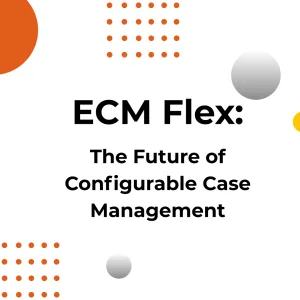Implementing HMIS Data Standard Changes
Many things mark the start of fall — leaves start to change color, Halloween items appear in stores and temperatures begin to get cooler. Every few years, a new item is added to this list — the Homeless Management Information System (HMIS) updates come into effect and system administrators in homelessness services programs across the country start the challenging task of ensuring they are implemented.
October 2021 was no different, with the HMIS FY 2022 Data Standard Updates becoming mandatory. The HMIS FY 2022 Data Standard Updates ranged from the simple to the complex – they focused on improvements around inclusivity for participants receiving services and, in theory at least, efficiency for frontline staff entering HMIS data.
Exponent Case Management’s HMIS Module
Luckily, Exponent Case Management’s (ECM) HMIS Module takes the hassle out of ensuring your program complies with updated data standards. ECM created the HMIS module to make managing your housing program easy. It was created with input from housing program experts and with a very close eye on the HUD HMIS standards and streamlines your reporting and data management.
Guiding Our ECM Customers Through HMIS Data Standard Changes
We will always ensure that we address any future HMIS data standard updates within the HMIS module, and we will ensure that all of our customers are fully supported during the transition to new standards.
For example, here are just some ways we supported our customers from the moment 2022 HMIS data standard changes were announced by HUD in May 2021:
- We kept our customers informed about the changes and the release schedule of these changes in ECM.
- We provided comprehensive documentation about the updates in the module, where they are located, and who they affect.
- We provided invaluable guidance to system administrators, clearly explaining the actions they needed to take to ensure they were compliant with the new standards.
- We met with each individual customer virtually to explain how each of the changes directly affected their system and answer any questions they had.
- We held further one-on-one meetings to support them with any issues that popped up.
We are fully committed to giving the same high level of service and responsiveness the next time HUD changes the HMIS data standards, giving service managers and system administrators one less thing to worry about!
Want a reminder of what changes in the 2022 data standards? Then we’ve summarised the key changes introduced in the 2022 HMIS Data Standards update at the end of this article.
Continuous Improvement
We felt privileged to be able to work with our customers to ensure their transition to the 2022 HMIS data standards was efficient and worry-free. We are committed to continuous improvement and we will always ensure we stay fully up to date with HMIS data standards., alongside our regular updates to ensure the HMIS module continues to make the lives of housing program staff easy,
Want to find out how ECM can help you transform the management of your housing program? Are you interested in learning more about our HMIS module and seeing ECM in action? Contact one of our experts who would be delighted to explore how we can help you or Sign-up for one of our biweekly webinars!
What Changed in the 2022 HMIS Data Standards?
The following is a summary of the changes introduced in the 2022 HMIS data standards that impacted data collection for program administrators and individual service providers. These changes are documented in full on page 2 in the FY 2022 HMIS Data Standards Data Dictionary under “Summary of Changes”.
Project Descriptor Data Elements
- Project Information (2.02)
- New Field: Medically Assisted living Facility.
- Rationale: This field was requested by HOPWA to determine if the HOPWA project is an assisted living facility.
- Applicability: All projects must answer this field, but only HOPWA projects would answer “Yes”.
- Funding Sources (2.06)
- New response options added to field 1 Funding Sources.
- HUD: CoC – Joint Component RRH/PSH
- HUD: HOME
- HUD: HOME (ARP)
- HUD: PIH (EHV)
- Rationale: Responses added to support programs affected by the American Recovery Plan.
- Applicability: All projects.
- New response options added to field 1 Funding Sources.
Universal Data Elements (applicable to all projects)
- Race (3.04)
- Response option labels updated in field 1 Race.
- American Indian, Alaska Native, or Indigenous
- Asian or Asian American
- Black, African American, or African
- Rationale: Response labels provide more inclusivity and representative language for all demographics.
- Response option labels updated in field 1 Race.
- Ethnicity (3.05)
- Response Option labels updated in field 1 Ethnicity.
- Non-Hispanic/Non-Latin(a)(o)(x)
- Hispanic/Latin(a)(o)(x)
- Rationale: Response labels provide more inclusivity and representative language for all demographics.
- Response Option labels updated in field 1 Ethnicity.
- Gender (3.06)
- Field type changed from a single picklist to a multi-picklist and response option labels updated in field 1 Gender.
- A gender other than singularly female or male (e.g. non-binary, genderfluid, agender, culturally specific gender)
- Transgender
- Questioning
- Rationale: Response labels provide actual gender options and more inclusionary and representative options.
- *Please note that “Questioning” refers to a participant who is searching and actively trying to understand their own gender identity. This is different from “Client doesn’t know” where the participant cannot answer the question.
- Field type changed from a single picklist to a multi-picklist and response option labels updated in field 1 Gender.
Common Program Specific Data Elements (applicable to all projects)
- Mental Health Problem (4.09)
- Field label changes in field 1 Mental Health Problem.
- Mental Health Disorder
- Rationale: Previous language of “Mental Health Problem” was outdated.
- Field label changes in field 1 Mental Health Problem.
- Substance Abuse (4.10)
- Field label change in field 1 Substance Abuse.
- Substance Use Disorder
- Rationale: Previous language of “Substance Use” was outdated.
- Field label change in field 1 Substance Abuse.
- Coordinated Entry Event (4.20)
- Additional referral response options.
- Referral to emergency assistance/flex fund/furniture assistance
- Referral to Emergency Housing Voucher (EHV)
- Referral to a special purpose voucher (homeless targeted units)
- Rationale: To collect additional referral information in response to pandemic relief.
- Additional referral response options.
Federal Partner Program Specific Data Elements
- New data element: Prescribed Anti-Retroviral (W6)
- New fields related to prescription anti-retrovirals: Has the participant been prescribed anti-retroviral drugs?
- Rationale: To document progression of any medication prescribed during a HOPWA-funded project participation.
- Applicability: All HOPWA-funded projects.
- Medical Assistance Data Element (W3)
- New field (and dependent field): Receiving Public HIV/AIDS Medical Assistance.
- Rationale: Track whether or not a participant is receiving Ryan White-funded medical or dental assistance.
- Applicability: All HOPWA – funded projects.
- New data element: Well-being Data Element (C1)
- New fields:
- Client perceives their life has value and worth.
- Client perceives they have support from others who will listen to problems.
- Client perceives they have a tendency to bounce back after hard times.
- Client’s frequency of feeling nervous, tense, worried, frustrated, or afraid.
- Rationale: Understand feelings of quality of life for the participants in homelessness programs.
- Applicability: HUD CoC: PH – Permanent Supportive Housing.
- New fields:
- New Data Element: General Health Status (R7)
- New field: General Health Status.
- Rationale: Understand participant’s feelings about their own health.
- Applicability:
- HUD: HUD-VASH – Required for HUD/Vash Other
- HHS: RHY – All projects except for Street Outreach
- HUD: CoC – Permanent Supportive Housing
- New Data Element: Moving on Assistance Provided (C2)
- New field: Moving on Assistance Provided.
- Rationale: To better understand the extent to which PSH clients participate in Moving On initiatives.
- Applicability: HUD CoC: PH – Permanent Supportive Housing.
- New Data Element: Youth Education Status (C3)
- New fields:
- Most Recent Educational Status.
- Current Educational Status (dependent field).
- Rationale: To get more details about youth educational situations.
- Applicability: HUD: CoC – Youth Homeless Demonstration Program
- Transitional Housing
- PH – Permanent Supportive Housing
- Services Only
- Other
- PH: Rapid Re-housing
- New fields:
- Financial Assistance (V7)
- Added/Updated Financial Type responses for Field 1 (collapsed 2 responses and added a new one):
- General housing stability assistance.
- Food assistance.
- Rationale: VA requested more efficient data collection.
- Applicability: VA: SSVF – required for Rapid Re-housing and Homelessness Prevention projects.
- Added/Updated Financial Type responses for Field 1 (collapsed 2 responses and added a new one):
- HP Targeting Criteria (v3)
- Significant restructure of fields and responses. Element re-named to remove “SSVF” as the element may become applicable for other partners. Removed scoring that were embedded in the answers. Everything is a dependency on field 1. Is Homelessness Prevention targeting screener required?.
- Rationale: Changes made to improve validity and reliability of results.
- Applicability: VA: SSVF – Homelessness Prevention.
- Formerly a Ward of Juvenile Justice System (R12)
- Updated field label for Dependent Field A.
- If Yes for “Formerly a Ward of Juvenile Justice System”
- Rationale: Corrected from previous version.
- Applicability: HHS: RHY – Collection required for all components except for Street Outreach.
- Updated field label for Dependent Field A.
- Family Critical Issues (R13)
- Update response labels for Fields 11 and 21.
- 11. Mental Health Disorder – Family member
- 12. Alcohol or Substance Use Disorder – Family member
- Rationale: Previous language was outdated.
- Applicability: HHS: RHY – Required for all components except Street Outreach.
- Update response labels for Fields 11 and 21.
- RHY Service Connections (R14)
- Update response labels for Fields 17 and 18.
- 17. Substance use disorder treatment
- 18. Substance use disorder Ed/Prevention Services
- Rationale: Previous language was outdated.
- Applicability: HHS: RHY – Required for all components.
- Update response labels for Fields 17 and 18.
System Logic Updates
- Project Exit Date (3.10)
- If auto-exit is offered, there must meet certain requirements:
- A standard to auto-exit a client after a certain length of absence from a program.
- A residential project client’s exit date would be the last date the client appeared at the program.
- A non-residential project client’s exit date must represent the last day a contact was made or a service was provided.
- If auto-exit is offered, there must meet certain requirements:
- Relationship to Head of Household (3.15)
- System logic added to ensure that there is at least one, but not more than one, HoH for each enrollment.
- Income and Sources (4.02) and Non-Cash Benefits (4.03)
- When a client ages into adulthood (18 yo), treat income updates as “update”
- Housing Move-in Date (3.20)
- Move-in date can only be on or between project start date and project exit date.
- T-Cell and Viral Load (W4)
- Applicability is for all household members with HIV/AIDS instead of only clients funded in a HOPWA project presenting with HIV/AIDS.
- Pregnancy Status (R10)
- Remove limitation of applicability to only female participants
Interested to learn more about our HMIS module and see ECM in action? Sign-up for one of our biweekly webinars!




